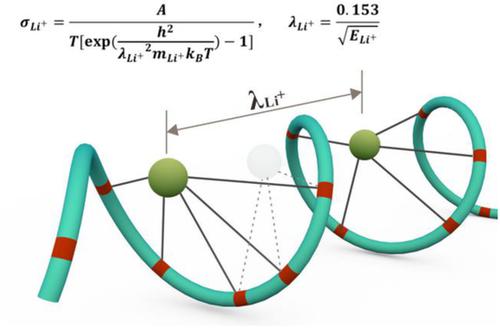当前位置:
X-MOL 学术
›
J. Polym. Sci.
›
论文详情
Our official English website, www.x-mol.net, welcomes your
feedback! (Note: you will need to create a separate account there.)
Quantum mechanical insight into the Li‐ion conduction mechanism for solid polymer electrolytes
Journal of Polymer Science ( IF 3.9 ) Pub Date : 2020-11-07 , DOI: 10.1002/pol.20200686 He Zhou 1 , Rongmei Zhao 2 , Yao Xiao 3 , Li Feng 1, 2 , Yibin Yang 1 , Lixia Bao 1 , Jiliang Wang 1
Journal of Polymer Science ( IF 3.9 ) Pub Date : 2020-11-07 , DOI: 10.1002/pol.20200686 He Zhou 1 , Rongmei Zhao 2 , Yao Xiao 3 , Li Feng 1, 2 , Yibin Yang 1 , Lixia Bao 1 , Jiliang Wang 1
Affiliation

|
Ion transport in polymeric electrolytes (PEs) has been studied for approximately a half century, yet the ion conduction mechanism in the PEs is not fully understood. Herein, we report a new approach to understand the ion migration process in poly (ethylene oxide)/Lithium bis(trifluoromethane sulphonyl) imide (PEO/LiTFSI) and poly (ethylene oxide)/Lithium bis(oxalate) borate (PEO/LiBOB) electrolytes based on quantum mechanics. The results show that the coefficient of determination (R2) obtained from the new model exceeds 0.99 for all the PEs, which is far higher than these obtained from the well‐known Arrhenius and Vogel‐Tammann‐Fulcher (VTF) equations. The wavelength (λLi+) of Li‐ion migrations or the distance between the occupied site and the neighboring partially‐occupied site is the most crucial factor to affect the ionic conductivity of PEs. The higher the λLi+, the better the ionic conductivity. The maximum λLi+ value of the PEs approximates angstrom order of magnitude. The developed ion conduction model opens an avenue to design PEs with a higher ionic conductivity.
中文翻译:

固体高分子电解质锂离子传导机理的量子力学见解
聚合物电解质(PEs)中的离子传输已经研究了大约半个世纪,但尚未完全了解PEs中的离子传导机理。在这里,我们报告了一种新的方法来了解聚(环氧乙烷)/双(三氟甲烷磺酰)酰亚胺锂(PEO / LiTFSI)和聚(环氧乙烷)/双(草酸)硼酸锂(PEO / LiBOB)中的离子迁移过程基于量子力学的电解质。结果表明,从新模型获得的所有PE的测定系数(R 2)均超过0.99,远高于从著名的Arrhenius和Vogel-Tammann-Fulcher(VTF)方程获得的测定系数。波长(λLi +锂离子迁移或占位点与相邻的部分被占位点之间的距离是影响PE离子电导率的最关键因素。较高的λ李+,更好的离子导电性。PE的最大λLi +值近似为埃量级。发达的离子传导模型为设计具有更高离子传导性的PE开辟了道路。
更新日期:2020-12-15
中文翻译:

固体高分子电解质锂离子传导机理的量子力学见解
聚合物电解质(PEs)中的离子传输已经研究了大约半个世纪,但尚未完全了解PEs中的离子传导机理。在这里,我们报告了一种新的方法来了解聚(环氧乙烷)/双(三氟甲烷磺酰)酰亚胺锂(PEO / LiTFSI)和聚(环氧乙烷)/双(草酸)硼酸锂(PEO / LiBOB)中的离子迁移过程基于量子力学的电解质。结果表明,从新模型获得的所有PE的测定系数(R 2)均超过0.99,远高于从著名的Arrhenius和Vogel-Tammann-Fulcher(VTF)方程获得的测定系数。波长(λLi +锂离子迁移或占位点与相邻的部分被占位点之间的距离是影响PE离子电导率的最关键因素。较高的λ李+,更好的离子导电性。PE的最大λLi +值近似为埃量级。发达的离子传导模型为设计具有更高离子传导性的PE开辟了道路。











































 京公网安备 11010802027423号
京公网安备 11010802027423号